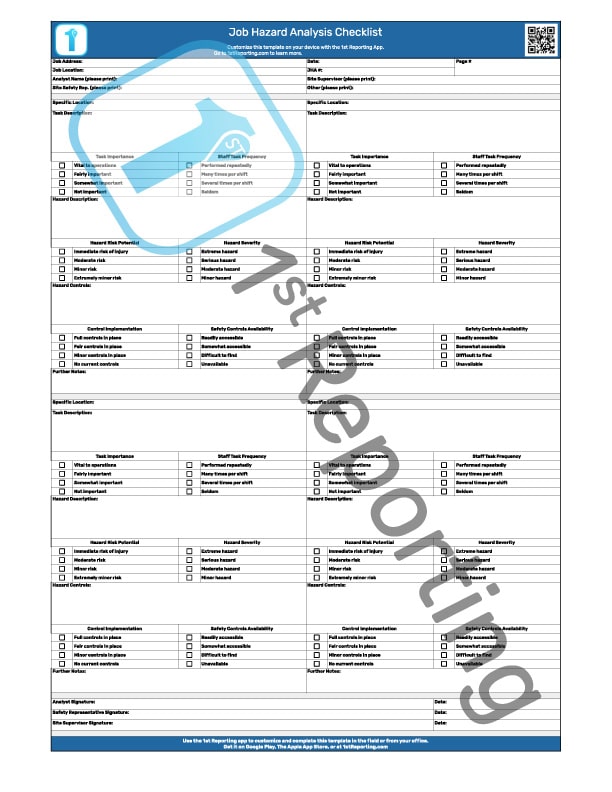Understanding incident rates such as OSHA’s TRIR Calculation (Total Recordable Incident Rate) is essential to business evolution to a safer tomorrow. Armed with an in-depth knowledge of how to ascertain and understand the metrics surrounding incidents properly, your company can better prepare. Preparation is the key to prevention.
The Total Recordable Incident Rate (TRIR) is a powerful metric for businesses and organizations to understand how their incident rate compares to industry standards. Moreover, if an organization meets OSHA record-keeping standards, annually reporting the TRIR rate is a requirement of the 300 and 300A OSHA Injury and Illness Recordkeeping Forms.
Above and beyond the natural reporting requirements is the TRIR’s ability to aid insight into the incidents occurring within your industry. Furthermore, the insights can assist your organization in making critical infrastructure changes to improve safety and avoid further incidents.
We will take you through all the angles of understanding the TRIR, from calculating it to understanding the inherent bias built into the calculation. Let’s dive in.
How Is the OSHA TRIR Rate Calculated?

The total recordable incident rate is not a complex calculation to comprehend. Here is the basic formula:
Number of Incidents x 200,000
Total Number of Hours Worked
If it isn’t clear, that’s the number of incidents times two hundred thousand divided by the total number of hours worked. Let’s quickly define each variable for clarification purposes.
- Number of Incidents – This number is the total recordable incidents within a year.
- 200,000—This number represents the number of hours that 100 team members (with 40-hour work weeks) work in a year with two weeks’ vacation (they work 50 weeks of the year).
- Total Number of Hours Worked
This formula is not to be confused with the Incident Rate Formula. (If you want to read about the Incident Rate Formula, see our article “11 Tips To Using The Incident Rate Formula In Your Business”.
Understanding The OSHA Lingo
Recordable Incidents – What Are They?
To further clarify the above formula, you might be wondering what is classified as a recordable incident. Well, according to the OSHA, a recordable incident meets any of the five following criteria:
- The incident involved a work-related fatality.
- The incident involved any work-related injury or illness that results in:
- Loss of consciousness
- Days away from work
- Restricted work
- A transfer to a different job
- Any work-related injury or illness requiring medical treatment that is more than basic first aid.
- Any work-related diagnosed case of:
- Cancer
- Chronic irreversible diseases
- Fractured or cracked bones or teeth
- Punctured eardrums
- There are also unique recording criteria for work-related cases involving:
- Needlesticks and sharps injuries
- Medical removal
- Hearing loss
- Tuberculosis
How Does OSHA Define First Aid Treatment?
Similarly, let’s see what the OSHA says about first aid treatment to make some clearly defined policies. According to the OSHA, twelve basic things determine first-aid use versus medical care:
- Use of nonprescription medication at nonprescription strength (like taking an over-the-counter pain killer, for example, is considered first-aid)
- Administering tetanus immunization (specifically)
- Cleaning, flushing, or soaking skin abrasions and wounds
- Applying typical bandaging such as gauze pads and self-sticking bandages.
- Using hot or cold therapy.
- Make use of a non-rigid means of support, like a tensor bandage or similar.
- Using temporary immobilization to secure a person for transport. This immobilization could include splints, slings, and similar devices.
- Applying an eye patch.
- Irrigation of the eyes to remove foreign debris (swab use is included for debris removal).
- Removing splinters from areas other than the eye using tweezers or simple means of removal.
- Drinking fluids (for relief of heat stress)
- Using massages (not to be confused with physical therapy or chiropractic treatment).
Now that we’ve clearly defined our formula and its complications, let’s look at a few examples of the formula in action.
Examples of the TRIR Calculation
Small Business

For our small business example, let’s assume the following:
- The business has 27 employees
- The team member workweek is 40 hours
- Employees work 50 weeks per year
- The company had two recordable incidents in a year
First, we need the total number of hours worked. That’s 27 times 40 times 50, or a total of 54,000.
Let’s run the numbers. Here’s our formula now:
2 x 200,000
54,000
= 7.41 (rounded)
This answer means that our small business has a TRIR of 7.41 or a rate of 7.41 incidents per 100 workers per annum. Now, let’s see how a medium-sized business might fare.
Medium-Sized Business

For our medium-sized business example, let’s assume the following:
- The business has 480 employees
- The team member workweek is 40 hours
- Employees work 50 weeks per year
- The firm had five recordable incidents in a year
These numbers tell us the total hours worked was 960,000. Therefore, our formula looks like this:
5 x 200,000
960,000
= 1.04 (rounded)
Large Sized Business

In our large-sized business example, we’re going to assume the following:
- The business maintains 3,487 employees
- The team member workweek is 40 hours
- Employees work 50 weeks per year
- The company had 28 recordable injuries in a year.
The total hours worked is a staggering 6,974,000 hours worked. Here is what our formula and answer look like now:
28 x 200,000
6,974,000
= 0.80 (rounded)
If you see a pattern, don’t fret, it is there, and it exists. But how does the bias work, and can one say that a small business suffers from the formula? Let’s look at that a moment.
Understanding Inherent Bias
The problem with the TRIR calculation is understanding how the formula vastly impacts small businesses. Many business owners take the results without a grain of salt.
The TRIR is intended to be utilized as a benchmark metric when analyzing a company’s safety performance compared to its industry and the industry as a whole.
The problem with small business TRIR calculations may come when we notice a small staff size and only a single or a couple of incidents. The TRIR goes up and away like a rocket. Why? Because the benchmark is at 100 employees (remember that 200,000 number?).
Understanding that the benchmark starts at 100 staff means that you know that even a single incident with less than 100 staff and the TRIR will appear skewed. This fact is the inherent bias in the formula. Naturally, the more significant the amount of staff compared to relatively small incident numbers per year will result in a stellar TRIR compared to industry standards. Similarly, a small company with only a few staff members will find themselves crucified by their TRIR comparison with only a single incident.
How To Solve TRIR Calculation Formula Bias

The answer for solving the issue of small team member pool bias in the formula is to use the calculation to determine the rate over several years instead of using a single year’s metric. As pointed out by Amanda Edens, Director of the Directorate of Technical Support and Emergency Management at the OSHA:
“Aggregation of multiple years of data can alleviate the unfavorable effect a single case can have on a small establishment’s incidence rate. For example, a small establishment can enter three years of injury and illness counts and three years of hours worked into the formula, while retaining the 200,000 constant. This would return an annualized rate for 100 FTE comparable to national rates. The increased hours worked figure would minimize any unusual swings in injury and illness counts.”
Amanda Edens, OSHA Director of Directorate of Technical Support and Emergency Management
So, with a bias against small businesses, how do we know what’s acceptable and what isn’t, even when using a multi-year calculation strategy?
What Is An Acceptable OSHA TRIR?
OSHA provides basic benchmark numbers each year that industries can use to determine their ability to keep incidents to a minimum. For example, in 2020, the US general incident rate was 2.7, as estimated by the Survey of Occupational Injuries and Illnesses and reported on the National Safety Council website.
If we take that number of 2.7 (that’s 2.7 incidents per 100 workers) and compare it to our three examples:
Small Business = 7.41 > 2.7
Medium Business = 1.04 < 2.7
Large Business = 0.80 < 2.7
Our examples show us the bias and show that both the medium and large business TRIR is good compared with the general industry for 2020. However, the metrics also show that the example small business has a rate over double the national average. It is possible that the example small business had zero accidents in the previous three years.
Small Business – A Biased Situation?
When calculating TRIR, small business owners need to understand that the small numbers will significantly affect their TRIR numbers. Ergo, smaller organizations should use a multi-year calculation approach to see more realistic numbers.
Businesses and organizations that wish to examine their TRIR numbers more thoroughly should also compare their results with those of their particular industry. Understanding how an organization fares relative to its competitors is also quite revealing.
Solutions For Recording And Tracking Incidents

Now that you have a solid understanding of TRIR and how the calculation works, let’s take a moment to look at the best solutions for recording, tracking, and analyzing incidents within your organization.
A Mobile Solution For OSHA TRIR?
The best solution for recording, tracking, and analyzing incidents within your organization is via a mobile reporting app such as the 1st Reporting app.
This smartphone and tablet form automation application allows team members to record incident information. It will enable you to track open cases over time and create custom reports based on the data collected. It can do this all from a mobile interface without you ever having to touch a spreadsheet!
Customization Is Key
Customizable templates mean you can create almost any audit sheet, inspection form, or report template required. With a customizable notification system included, you can use the app for more than incident reporting. You can use it to automate information-sharing processes and create customized reports.
Suppose you’re looking for simplicity in a user interface and versatility in a robust application. In that case, this is the tool that you need to keep OSHA compliance in effect. You can find more information on our website or download our Android or iOS app from Google Play or The Apple App Store. With 1st Reporting, OSHA TRIR compliance is just a swipe away!





